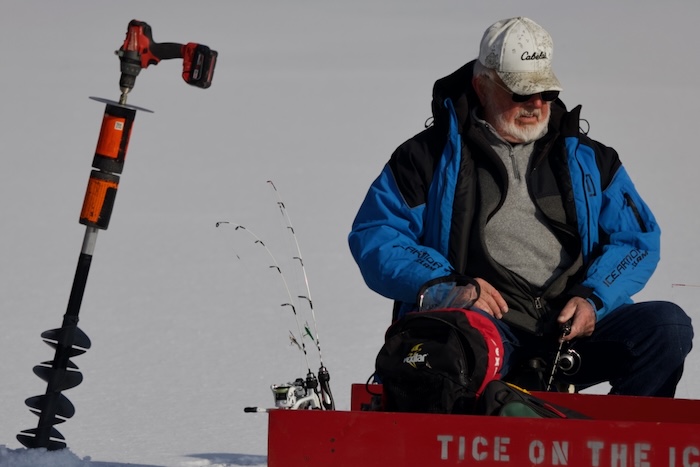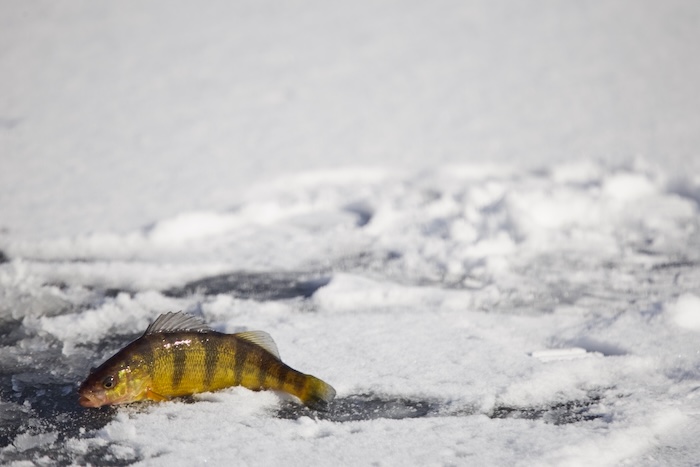Myron Tice is a passionate ice fisherman with business cards that read “Have Ice? Will Travel!” Thanks to global warming, the 85-year-old Philipstown resident has been traveling a lot in recent years, trekking as far north as Lake George and Lake Ontario searching for fishable ice.
When I asked Tice to take me fishing last week, I was hoping we wouldn’t have to travel that far. Ice fishing in the Highlands opened Jan. 14 on Canopus Lake in Fahnestock State Park, the first time since the pandemic winter of 2020-21. Park regulations require 6 inches of ice before opening lakes for winter sports.

Canopus Lake anglers last week wasted no time dropping lines and catching yellow perch and largemouth bass. “It’s a miracle that we can go ice fishing this year,” said Brian Booth, of Millbrook. “I got out three days last year, but it was not optimal.”
Tice agreed to take me fishing on the condition that I wore warm boots, a requirement I appreciated given my propensity to get dizzy and even faint in extreme cold. It happened last year while cross-country skiing in Vermont and years earlier while winter fly-fishing on the Chattahoochee River in Atlanta, where I’m from. For the record, I caught five rainbow trout that day, a fact usually omitted when my wife recalls how she drove to rescue me.
When I met Tice at the B&L Deli on Route 9 last Friday morning, it was 25 degrees and I was bundled warmly in a battery-heated fleece, long johns, fur-lined boots and mittens stuffed with chemical hand warmers.
“We might not catch anything,” Tice warned as I boarded his truck. “There’s a front coming that could hurt the fishing.”

Tice grew up in Buchanan, ice fishing on the Croton Reservoir. As a teenager, he once brought home a 12-inch-thick chunk of ice to prove to his mother a local lake was safe for play. “We don’t get ice like that anymore,” he said.
On Friday, we fished the West Branch Reservoir in Carmel. To ensure the ice was safe, Tice chiseled a hole with a 5-foot-long iron bar. Four years ago, he fell into Lake Otsego near Cooperstown. “I pressed down with my foot and fell in,” he said. The water was over his head. He leaned on the ice and kicked with his feet to get out. Then he drove three hours home, having done no fishing. Tice’s wife, Susan, now forbids fishing alone, a rule my wife also favors.
We towed Tice’s gear-laden sled to a spot 50 yards from the road. Using an ice auger and a power drill, he made three holes — one for me, one for him and one for the Vexilar sonar fish finder, which indicated we were fishing in 22 feet of water.
The fish finder was an innovation over the other time I went ice fishing, about 35 years ago on a frozen pond in Montrose, near where Tice grew up. Through a friend, I had met a Vietnamese man named Dang who wanted a fishing buddy. Dang spoke little English but was a fine angler. Amazingly, we caught 50 crappies in an hour and then left. For bait, we used white maggots from a local bait shop.
This time, Tice and I fished with maggots he bought online from Ja-Da Bait in Pulaski, Wisconsin. Two bags of 1,000 maggots cost $40, enough for the season. “I give leftovers to the chickens,” he said.

Tice sometimes fishes with eyeballs gouged from a freshly caught perch. The retired union carpenter and construction worker has even fashioned a wooden tool with a metal scooper to do the gouging. For the record, no eyeballs were gouged for this story.
The maggots produced three yellow perch, which we tossed on the ice. I also caught a white perch deemed too small. We dropped it back in the hole. A nearby angler caught a gorgeous 20-inch brown trout. Tice said the biggest fish he ever caught ice fishing was a 2-foot pike on Cayuga Lake in Ithaca.
For lunch we ate perch fillets that Tice made at home. They were fried after being dredged in egg and breadcrumbs with a little salt and pepper. They tasted like fish candy. Delicious.
At 12:30 p.m., we left. “We didn’t get skunked,” said Tice. “We didn’t catch as many as we wanted. But that’s fishing.”
I was just happy I didn’t faint.

